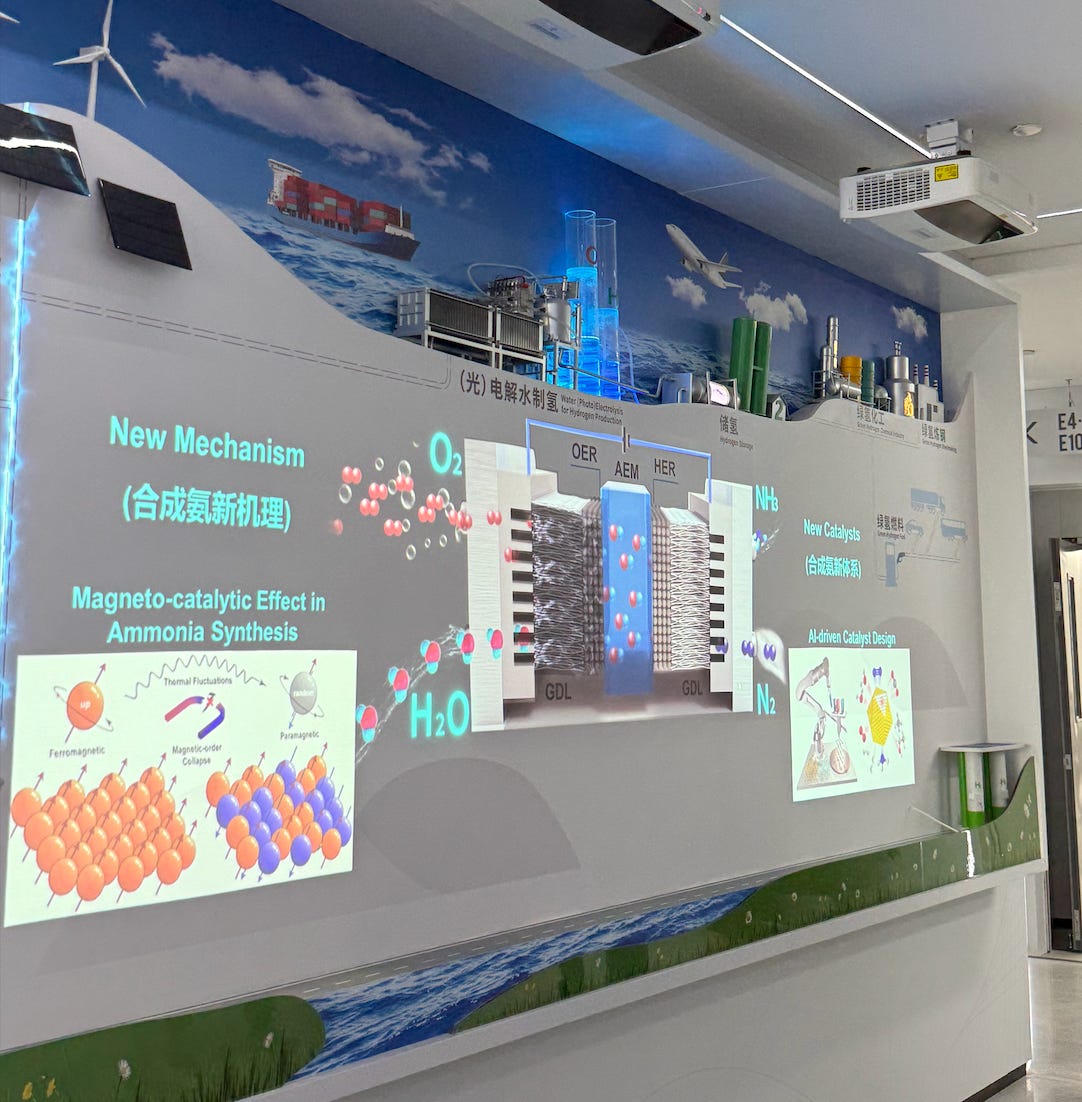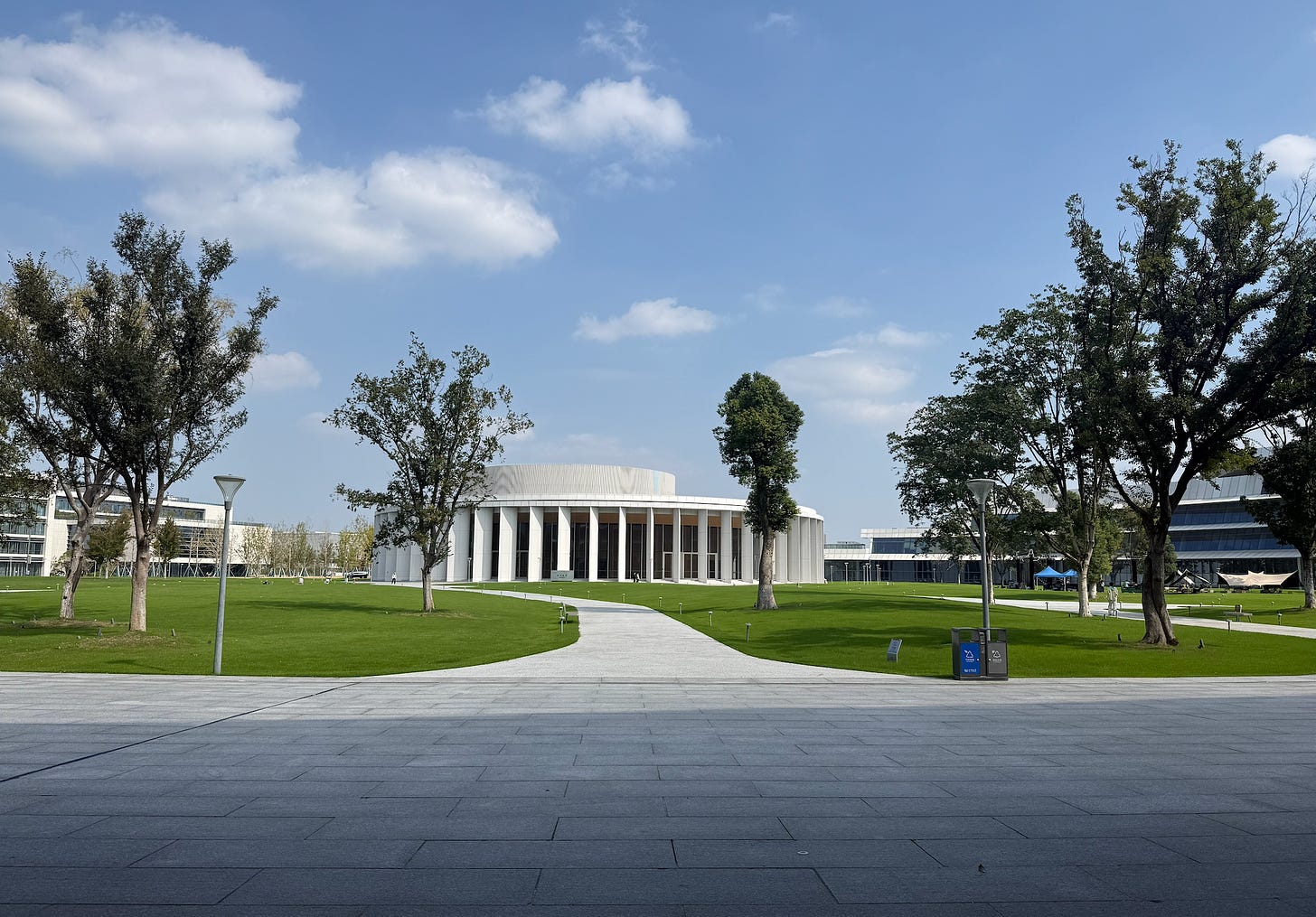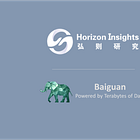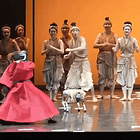How China innovates higher education to select and train world-class STEM talent
Field notes from a visit to Westlake University
Earlier this year, I wrote about Hangzhou as the city behind DeepSeek’s rise in the newsletter Hangzhou: The city behind DeepSeek’s rise and why it’s just the beginning. In that piece, I argued that DeepSeek wasn’t an outlier or a one-shot accident, but a product of Hangzhou’s burgeoning private business ecosystem.
But there is a deeper layer to this story. China’s tech innovation doesn’t come out of nowhere; it flows from a massive, rigorously selected STEM talent pool. (For instance, DeepSeek’s founder and core team are local talents from Zhejiang University in Hangzhou, one of China’s most prestigious research universities.)
To truly understand the future of Chinese tech, you have to look at how that talent is made.
In this newsletter, I want to take you inside Westlake University — China’s first privately funded research university, also based in Hangzhou. During Baiguan’s very first China tour in late October, we visited Westlake University in Hangzhou, which offers a rare peek into how the country is innovating its higher education system to select and train the next generation of scientists, researchers, and world-class STEM talents.
The context: How China’s broader education system works
When we talk about China’s higher education, we are usually describing a contradiction.
On the one hand, you have students studying insane hours, weekends included, with their fates sealed by a single score on the Gaokao (the national college entrance exam). There is a popular saying in China: “A single point on the Gaokao can crush thousands of competitors.“ It is brutal, stressful, and for many, results in a degree that doesn’t guarantee a job as the youth unemployment rate keeps climbing in recent years.
On the other hand, this same system produces students who dominate international math and science competitions, found groundbreaking companies, and drive technological breakthroughs globally.
How can a system be so stressful yet so effective?
All coins have two sides — the system isn’t designed to fit everyone, but it’s exceptionally good at selecting STEM talent. For quantifiable subjects, exams are simply the fairest way to give everyone — rich or poor — a shot at changing their fate. The Gaokao system is, in my opinion, less of an “education” system and more of a meritocratic selection mechanism.
However, in recent years, the system has faced a growing crisis of quantity over quality. Since 1999, China has massively expanded college enrollment. From 1998 to 2001, total higher-education enrollment nearly doubled. It relieved unemployment pressure at the time and raised overall education levels — but also created issues: too many poorly designed majors, student-to-faculty ratios ballooning, and degree inflation that left many graduates misaligned with the job market.
This backdrop—the need to build a parallel track to nurture top-tier talent—is why a case study of Westlake University matters.
Westlake University: a case study in educational innovation
It is easy to imagine that the entire Chinese higher education system works like the aforementioned exam-based, rote memory syllabus, and cutthroat machine. Westlake University is the opposite. It is small, flexible, research-driven, and deeply selective. And because it is private, it moves fast and has the freedom to choose exactly how it runs itself.
In China, where higher education is traditionally dominated by the public system, the concept of a private research university was almost unthinkable just a decade ago. Yet Westlake, founded only in 2018, is already attracting top talent globally. The proposal was made in 2015 by seven prominent scholars and entrepreneurs; it was quickly approved by Hangzhou and Zhejiang Province, and the government helped build a massive, brand-new campus with world-class labs in just a few years.
Westlake University is now home to a faculty of internationally recognized scholars, including Shi Yigong, a leading biophysicist and the university’s founder and current president.
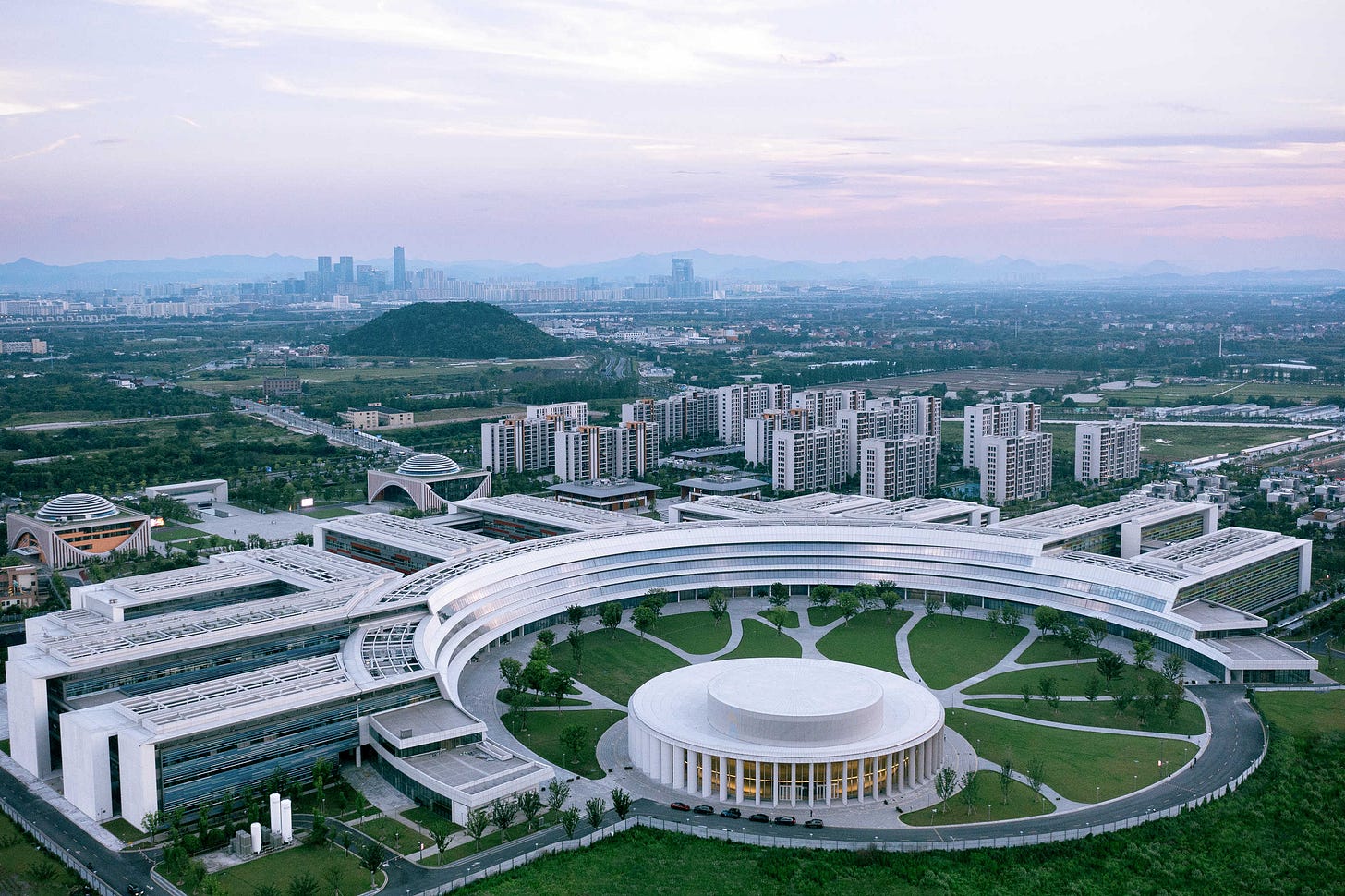
Here is how they are doing it differently:
1. True “Liberal Education”—or rather, “teach students in accordance with their aptitude” (因材施教)
Westlake provides what the West might call a “liberal arts” education, but I prefer the Confucian concept of “因材施教 Yincai Shijiao”—teaching in accordance with the student’s aptitude.
This has long been the ideal of education in Chinese history, but due to massive college expansions, few universities today have the capacity to actually implement it. Westlake does, largely because it limits its scale to focus on quality. The university hosts only about 200 undergraduates compared to 2,700 PhD students and 300 professors, concentrating intensely on STEM and medicine rather than trying to be a comprehensive giant.
Because of this small ratio, the curriculum is highly personalized and interdisciplinary. For the first two years, undergraduates don’t even choose a major; instead, they choose a mentor. Based on mutual research interests, professors and students select each other, allowing students to explore research fields before committing. The atmosphere mirrors top US research universities, with students living in one of four residential colleges where they socialize and participate in extracurriculars with dorm-mates across different disciplines. Remarkably, for this level of education, the tuition for local students is just 6,000 RMB (approx. $845 USD) per year.
From Day 1, Westlake has been committed to a global standard of research. All classes are taught in English, and it is mandatory for undergraduates to study abroad for a semester or a year, supported by need-based scholarships.
The most fascinating part of Westlake is how they pick these students. The process is designed to find “prodigies,” with prospective students taking Westlake’s own exam before the national Gaokao. Remarkably, 60% of their admitted students have skipped a grade. Even though they are younger than the average high school senior, their Gaokao scores are typically only about 20 points shy of the ultra-elite Tsinghua or Peking University standards.
But high scores are just the prerequisite. Finalists must attend a 3-day assessment at the university where professors might deliver a lecture on a topic the students have never heard of, then test them on the spot to gauge their learning agility rather than rote memory. Students must also deliver a full English presentation. In Westlake’s values, they want talented minds who know, from very early on, that they want to become scientists and researchers.
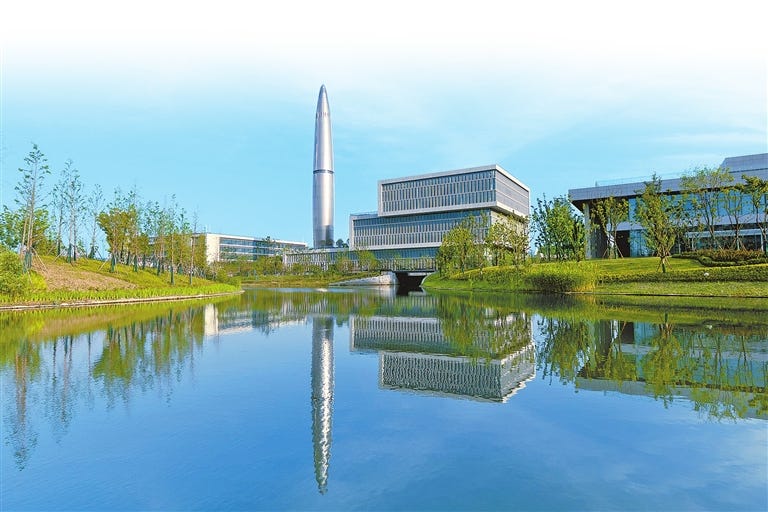
2. Embracing curiosity and the unknown
As a research university, curiosity and a willingness to embrace the unknown are deeply rooted in Westlake’s values. You can see this in their hiring strategy: they prioritize young professors—the average age is just 42, and 85% have overseas experience. Notably, 66% were recruited through state-sponsored talent acquisition programs designed to repatriate top scholars globally, ensuring that the faculty consists of world-class researchers returning to China with fresh perspectives.
During our lab tour, the team shared a story that perfectly captures this culture. Led by Dr. Sun Licheng, the group was researching bio-membranes designed to convert greenhouse gases like carbon dioxide into useful resources. They were specifically hunting for a cost-effective alternative to electrolyte membranes, which traditionally rely on expensive noble metals.
The breakthrough arrived by accident. The team discovered a watermelon that had been left in a forgotten lab refrigerator. When they found it, the skin had already naturally detached from the fruit due to the cold.
The team got curious: could the skin be useful? They decided to experiment. They took the skin, froze it, restored it to room temperature, and tested it. It worked—the material offered efficiency and dynamic response times that rivaled expensive noble metals. The professor told us this reflects their core philosophy: “start from nature and make some artificial things from it.”
In fact, this watermelon skin research won the Pineapple Science Award—a prize established in Zhejiang in 2012 (similar to the Ig Nobel Prize) to celebrate curiosity-driven, imaginative, and humorous research. It is a telling detail: when a university is rooted in a province that actively celebrates this kind of curiosity, it is likely no coincidence that tech talents and unicorns like DeepSeek are emerging from this city.
3. The governance model
As the first private research university in China, Westlake operates with a level of freedom that public universities simply don’t have. While public universities are led by a Party Committee, Westlake operates under a Board of Trustees leadership system where the Principal takes responsibility. The board includes heavyweights like Nobel laureate Yang Chen-ning, scholars, as well as entrepreneurs.
The funding model is a unique hybrid. The state provides the “hard assets” like land and lab equipment, but the private foundation covers the day-to-day costs such as salaries and operations. This allows them to pay market rates to attract top global talent. For instance, the university would tailor one lab for the newly hired professor to make sure he or she gets all that’s needed for the research.
This governance structure also leads to highly pragmatic and comprehensive decision-making. The Board of Trustees includes renowned scholars—such as former Vice Presidents of Tsinghua and Peking University—sitting alongside major entrepreneurs, including a co-founder of Alibaba Cloud. With one-third of the trustees being entrepreneurs (who have donated over 200 million RMB), the university bridges the gap between academia and industry. This means graduates are trained not just for foundational research, but also for down-to-earth, practical entrepreneurial work. In fact, Westlake has already incubated 52 high-tech enterprises, most of which are based right here in Hangzhou.
Since it relies on a foundation rather than the state for operations, Westlake is currently receiving donations but has reimagined fundraising in a way I’ve rarely seen elsewhere in China. We heard a fascinating anecdote about their donation flexibility: naming rights can extend down to specific seats in the auditorium. Someone, for instance, sponsored Row 5, Seat 3 simply because it matched their birthday. They even accept small donations via Alipay. By lowering the barrier to entry, the university found a fun way to maintain the deep connection supporters—both in China and abroad—have with the school, regardless of the amount they could afford to give.
This kind of flexibility is unheard of in traditional Chinese universities, but it makes perfect sense in Hangzhou—a city where the entrepreneurial private economy contributes over 60% of GDP and accounts for over 90% of all business entities.
Some say Hangzhou is becoming China’s Silicon Valley, and it’s an accurate analogy. Its population is digitally savvy and entrepreneurial, while prestigious institutions like Zhejiang University and Westlake University provide talent and fuel technological development. This ecosystem has birthed Alibaba, as well as the “Six Little Dragons”—influential startups including DeepSeek, Unitree, Deep Robotics, and Game Science (creators of Black Myth: Wukong).
The broader innovation in China’s talent selection
Westlake isn’t alone. China has started building new pathways to cultivate foundational research talent.
Since 2020, China’s Ministry of Education has rolled out the “Pilot Reform Program of Enrollment for Fundamental Disciplines” (强基计划). This program targets students who are exceptional in foundational fields—math, physics, chemistry, biology, history, philosophy, and ancient linguistics.
The pilot program only involves a selected group of elite universities in China, and Admission is based on a composite score: at least 85% from the Gaokao (college entrance exam) plus about 15% from a school-administered test. Once admitted, students get specialized training: smaller classes, a mentor system, and are designed to support “undergraduate → master → PhD” pathways.
By 2023, the program had evolved: some schools added more interdisciplinary and strategy-relevant majors (e.g., AI, new materials), and tightened selection thresholds.
On this front, I have never doubted China’s ability to ensure its top STEM talent is selected and trained. This is not to ignore the obvious issues: the stressful exam-based system, massive class sizes, and degree inflation remain alarming problems for the average student. But for the true high-performers, it is fair to say that China’s higher education remains an effective meritocracy.
To be fair, even the average baseline is high. The average high school student here possesses math skills that often outstrip their counterparts in other countries—a disparity that becomes evident if you compare the difficulty of China’s standardized exams against Western equivalents like the SAT subject tests or AP tests. These innovations in education act as finer filters on an already massive, capable pool.
Such a system may not be optimal for liberal arts talent, but if you are good at math and science, you will have a fair opportunity. That reality lies the foundation for the sheer volume of brilliant scientists, researchers, and engineers coming out of China.
*Westlake University now operates primarily through its endowment and still relies on donor support. If you’re interested in learning more about its funding model or making a contribution, feel free to reach out to us.




